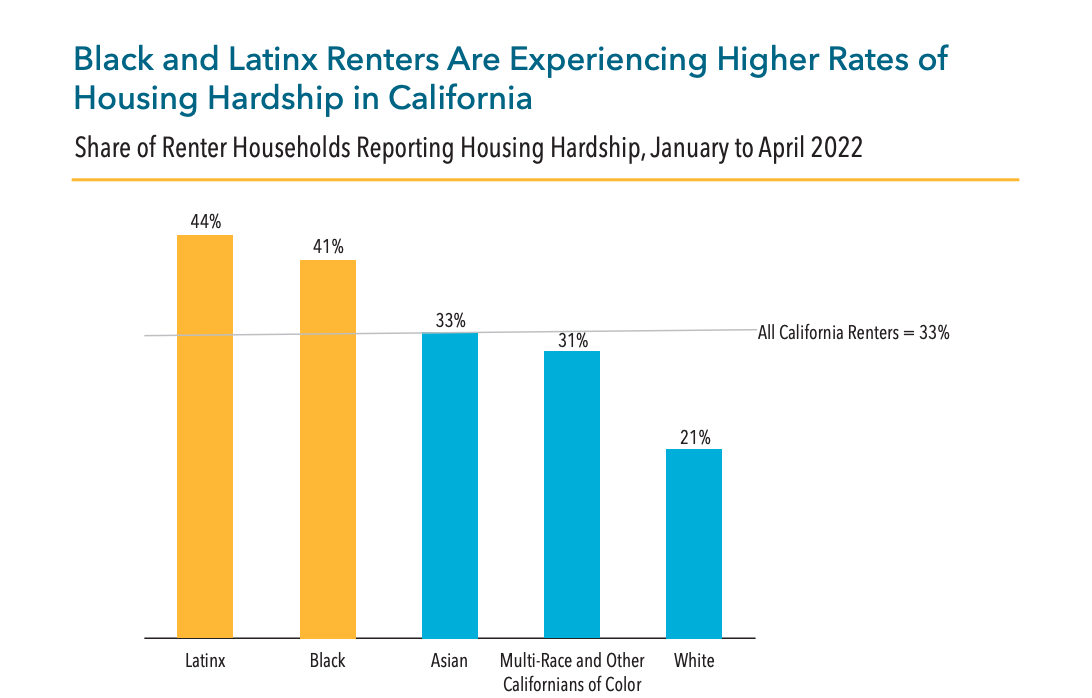
Decades of systemic racism and economic inequality have led the cost burden of renter households to vary across racial groups, which can be seen by looking at the charts available in the California Housing Partnership’s Housing Needs Dashboard.[i] Typically, households are considered cost burdened if thirty percent or more of their income is allocated towards housing costs and severely cost burdened if fifty percent or more is allocated towards housing costs. In the chart below, these are represented in light red and darker red, respectively. The loss of affordable housing in California has added pressure on the supply of affordable housing, eventually leading to higher rents.[ii] In addition, rent increases on low-income individuals and families mean they likely must cut back on spending for other essentials, such as food, transportation, and clothes.[iii]
 Looking at the “Cost Burdened Renter Households By Income” chart in the Partnership’s Housing Needs Dashboard for California, above, the highest cost burdens fall hardest on extremely low-income households. From left to right, the percentages for cost burdened and severely cost burdened households decrease as individuals and families become better off due to high incomes.
Looking at the “Cost Burdened Renter Households By Income” chart in the Partnership’s Housing Needs Dashboard for California, above, the highest cost burdens fall hardest on extremely low-income households. From left to right, the percentages for cost burdened and severely cost burdened households decrease as individuals and families become better off due to high incomes.
Another chart titled, “Cost Burdened Renter Households By Race & Ethnicity,” provides a comparison between cost burdened and severely cost burdened renter households for the major racial and ethnic groups in California.
According to the chart above, we see that people of color generally face the highest rates of cost burden in the state, especially Black and Latino renters, and those identifying as Native American and Other Pacific Islander. Furthermore, the California Budget & Policy Center recently published a report on which racial groups are facing housing hardships in the state due to the impacts of the pandemic, which has further exacerbated the trends seen above.[iv]
One of the four core goals of the Roadmap Home 2030 – California’s long-term, comprehensive, evidence-based plan to eliminate homelessness and the affordable housing gap – is to increase racial equity.[v] Through the support of numerous policy proposals and programs in the Roadmap Home, we hope to see California close the wealth and racial equity gaps in affordable housing.
_
Sources:
[i]California Housing Partnership, 2022. “Housing Needs Dashboard.” Website: https://chpc.net/housingneeds/
[ii]California Housing Partnership, 2022. “Affordable Homes at Risk.” Website: https://chpc.net/resources/affordable-homes-at-risk-2022-report/
[iii]California Housing Partnership, 2021. “Policy Brief 2021: Who Can Afford to Rent in California’s Many Regions?” Website: https://chpc.net/?sfid=181&_sf_s=who%20can%20afford%20to%20rent%20in%20california%27s%20many%20regions&_sft_resources_type=fair-housing
[iv]California Budget & Policy Center, 2022. “Who is Experiencing Housing Hardship in California?” Website: https://calbudgetcenter.org/resources/who-is-experiencing-housing-hardship-in-california/
[v]California Housing Partnership, 2022. “California’s Roadmap Home 2030.” Website: https://chpc.net/roadmaphome2030/


